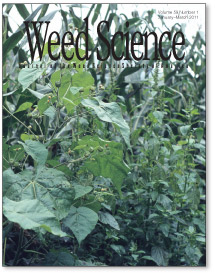
 July 14, 2011 – Herbicide
July 14, 2011 – Herbicide
resistance is growing. At least 21 weed species have now developed resistance
to glyphosate, a systemic herbicide that has been effectively used to kill
weeds and can be found in many commercial products. Some weeds are now
developing resistance to alternative herbicides being used. New occurrences of
resistance are being noted in varying weed species and locations, creating
challenges for weed scientists.
July 14, 2011 – Herbicide
resistance is growing. At least 21 weed species have now developed resistance
to glyphosate, a systemic herbicide that has been effectively used to kill
weeds and can be found in many commercial products. Some weeds are now
developing resistance to alternative herbicides being used. New occurrences of
resistance are being noted in varying weed species and locations, creating
challenges for weed scientists.
Several articles in the
current issue of the journal Weed Science focus on the issue of herbicide
resistance. The articles highlight first reports of resistance. “The herbicide
resistance issue is becoming serious,” the journal’s editor, William K.
Vencill, said. “It is spreading out beyond where weed scientists have seen it
before.”
 |
|
Palmer amaranth is a
common weed that competes with cotton, soybean, corn, grain sorghum, and peanut
crops in the southern United States. A density of 10 of these weeds per row of
cotton has been shown to reduce yields more than 50 percent. By 2010, 52
counties in the state of Georgia had infestations of glyphosate-resistant
Palmer amaranth.
Field and greenhouse tests
conducted for the current study now confirm that this weed is resistant not
only to glyphosate, but also to phrithiobac, an acetolactate
synthase-inhibiting herbicide. This marks one of the first reports of multiple
resistance to both glyphosate and pyrithiobac in Palmer amaranth. As multiple
herbicide resistance becomes more common, a grower’s ability to be economically
sustainable is threatened.
Another study in this
issue conducted dose-response, ammonia accumulation, and enzyme activity tests
on glyphosate-resistant Italian ryegrass populations taken from hazelnut
orchards in Oregon. This research now confirms resistance of Italian ryegrass
to another control alternative, glufosinate ammonium, a nonselective
broad-spectrum herbicide.
In West Memphis, Ark.,
another study reports the first documented glyphosate-resistant johnsongrass
biotype in the United States. A soybean field in continuous production over 6
years showed reduced control of johnsongrass with the recommended application
rate of glyphosate. A greenhouse study was conducted with this johnsongrass to
confirm this finding and determine any differences in absorption or
translocation of the herbicide within these plants.
As herbicide resistance
spreads, growers will need new weed management strategies. These could include
herbicides with alternative sites of action within the plant or nonchemical
methods such as tilling and mulching. Growers should prevent resistant weeds in
a production field from reaching reproductive maturity to prevent spread of the
trait through seed or pollen.
Full text of “Multiple
Resistance in Palmer Amaranth to Glyphosate and Pyrithiobac Confirmed in
Georgia,” and other articles in Weed Science, Vol. 59, No. 3, May-June 2011,
are available at http://allenpress.com/publications/journals/wees.
Print this page